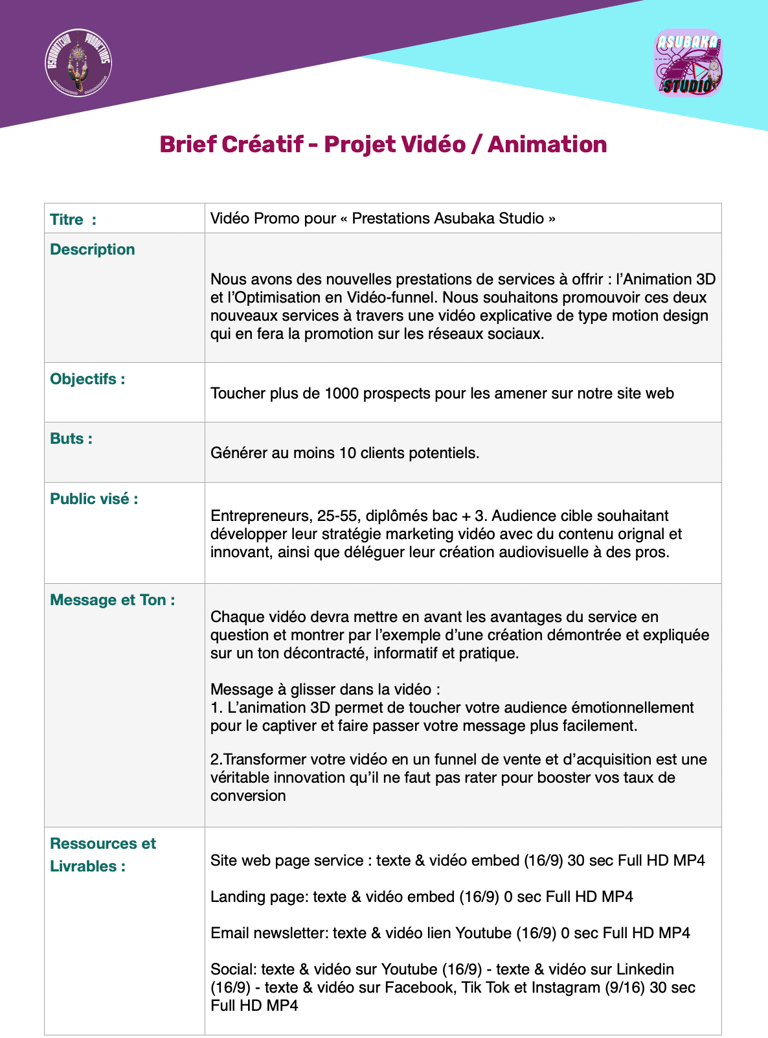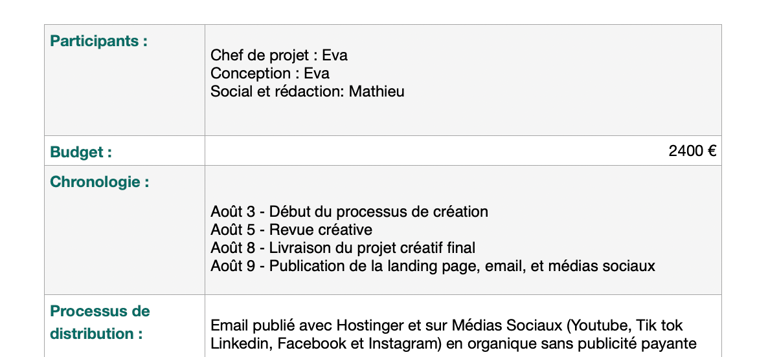The Importance of the Creative Brief in Project Planning
Before any video project is carried out, Asubaka Studio carries out a briefing with its clients in order to determine the ins and outs of the project which will be recorded in an essential document called: the creative brief.
CREATION PROCESS


Introduction to the Creative Brief
For every project, it is very important to establish a clear plan and set quantifiable objectives for all creative activities before starting. This is where the creative brief comes in. This valuable document serves as a guide for the planning and execution of all creative projects, facilitating each step of the process when working alone or in a team.
The brief therefore reassembles all the useful and relevant information concerning the project to be carried out, it also integrates stages of the creative process that must meet the objectives and deadlines imposed by the finished project.
Establish Objectives and Deadlines
One of the main advantages of the creative brief is the ability to define the specific objectives of the project. It is by clearly identifying its scope, deadlines and expected deliverables, that a smooth and efficient execution will then be possible, especially during a joint project with an internal team, as well as with external collaborators such as clients. These well-defined elements help keep all stakeholders on the same page, reducing the risk of frustration or confusion.
Planning and Coordination
Writing a creative brief is an opportunity to take the lead and take stock of all creative needs. This documentation not only allows you to plan specific tasks, but also to coordinate the team's efforts. By planning the different stages well defined beforehand, better collaboration and a common understanding of the project's objectives will be ensured.
Project Scope and Deliverables
The creative brief offers the opportunity to specify the specific details relating to the scope of the project. Thus, describing the expected deliverables as well as the success criteria, allows you to effectively measure the progress and quality of the work carried out. A clear definition of these elements is crucial to avoid any later misunderstanding and ensure that the results perfectly match expectations.
The key elements of a good creative brief
A brief written with as much detail as possible saves a lot of time and will avoid any unnecessary exchanges with collaborators.
There are key information points that are imperative to include during the first briefing meeting. There are usually 9, but this is not an exhaustive list, and it can be adapted to any type of project management.
Title and description: name and summarize the concept and nature of the video project by being concise and clear.
Goals and objectives: answer the "why does this video project exist"; what problem does it address and what solution(s) does it provide concretely, but also within what time frame it must be carried out, as well as the different operational and quantified steps that must be completed to achieve the desired goal.
Target audience: describe as precisely as possible your ideal customer to whom this deliverable will be addressed by analyzing the targeted consumers (age, level of education, income, geographical, cultural, family situation, interests, values, needs, desires, etc.)
Message and tone: embody your ideal target customer to know how to address them (with what voice; warm, informal, relaxed, etc.) and understand what they want or need to hear, see, experience, etc. What feeling will this provoke in them (desire, satisfaction, curiosity, fear, etc.) and what reaction will this trigger (request for additional information, purchase, subscription, etc.).
Resources and deliverables: provide here the existing elements to be integrated into the projects such as images, graphic charter or videos and specify the nature of the deliverable(s): content style, duration, number, text to be integrated, etc.
Participants: define here the team members and their exact function to successfully complete the creation of the project.
Budget: draw up the financial plan or the estimate to know the final price of the completion of the project from A to Z.
Chronology: decide on a start date and a deadline, and add all the important dates in between.
Distribution process: select the broadcast channels, on which media to distribute the final project? Internet and social networks? Television or movie theaters? It is essential to know this in advance to adapt the format of the video.
Example of a creative brief for a motion design video project:




Conclusion
In short, the creative brief is designed to allow all collaborating participants to understand each other perfectly, thus avoiding constant back-and-forth to correct aspects of the project that may have been poorly explained or perceived.
By establishing clear objectives, realistic deadlines and a precise definition of deliverables, the necessary foundations for the success of the creative project are thus put in place. By investing time in the creation of a precise and detailed brief, not only is the effectiveness of any collaboration maximized, but also the quality and consistency of the project outcomes.


